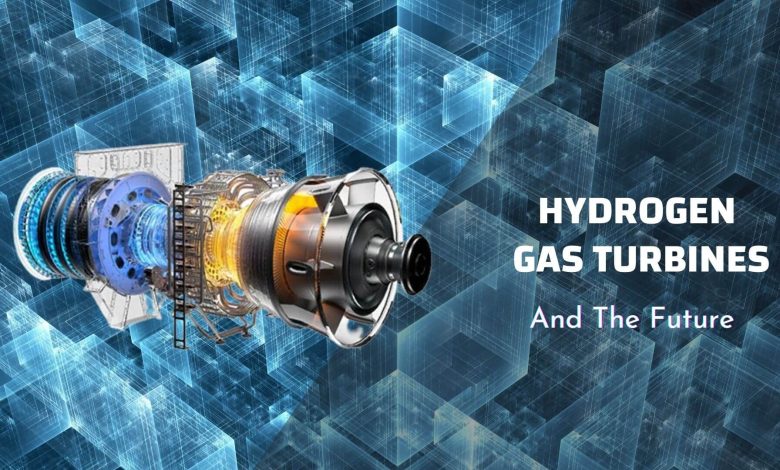Hydrogen To Power The World With Innovative Gas Turbines

The energy sector is in a continuous state of transformation. Stricter emissions regulations have coincided with a shift in popular sentiment toward environmental sustainability. Efficiency has long been a priority in the turbomachinery industry, but with governments throughout the world promising carbon neutrality by 2050, the ultimate goal for OEMs has taken on new significance. While competing with wind, solar, and battery storage technologies, gas turbine is predicted to burn a wider range of fuels and be more versatile in their applications.
Gas turbine technology continues to progress, whether or not hydrogen is used. According to forecasts from the International Energy Agency, natural gas generation will continue strong for decades. Alternatives like hydrogen, on the other hand, have sparked a lot of attention due to their clean-burning properties and government assistance. As a result, most manufacturers produce turbines that can handle a natural gas-hydrogen combination to some extent. They are developing future-proof turbines that can run on 100% hydrogen or a high hydrogen blend efficiently.
General Electric
H-class, F-class, B, and E-class gas turbines, as well as aero-derivative turbines, are among GE’s well-known gas turbines. GE also offers turbine Control system parts, which monitor and protects against dangerous conditions. IS200EGPAG1B and IS200TBAIH1C are some examples for this. The HA and F-class turbines have the most power and fuel flexibility. Constrained consumer budgets and availability to finance due to oil prices and economic slowdowns have hampered the company’s ability to close transactions, notably services parts and upgrades. Overcapacity in the industry, rising price pressure from competition on servicing the installed base, and the unpredictable timing of transaction completion, according to GE, will continue to affect the power market. In 2021, the company has received 32 orders. The business is still the leading gas turbine maker. Approximately 30% of units built over the next decade expected to come from it.
The 384 MW 7HA.02 combustion turbine from GE is noted for its capacity to burn diverse gas blends at high power and efficiency. It can burn between 15-20 percent hydrogen by volume. The turbine is being deployed at the Long Ridge Energy Terminal in Ohio, a 485 MW combined cycle power plant that will switch to hydrogen as early as next year. The factory is the first of its kind in the United States.
Ansaldo Energia
For the combined cycle and peaking markets, Ansaldo Energia is developing larger and more efficient H-class gas turbines. The part-load operation, high turndown, and cycling operation are all flexibility features that support renewables and the needs of large combined-cycle plants.
Furthermore, the company is improving the hydrogen combustion capabilities of all new and retrofit engines. The key to designing blended fuel turbines is to minimize the negative consequences of hydrogen combustion, such as derating, which reduces power output and efficiency, increases emissions, and reduces operational flexibility. In its AE94.3A gas turbine, the business has already burned hydrogen-enriched fuels for almost 200,000 hours.
For hydrogen combustion, sequential combustion technology, such as that used in Ansaldo Energia’s GT26 and GT36 turbine models, has advantages. The engine’s sequential combustion is adequate for hydrogen combustion, according to the results of the most recent high-pressure tests performed under full engine settings.
OPRA
OPRA, a Dutch turbine manufacturer, has developed combustor technology that allows its gas turbines to run on up to 100% hydrogen. It successfully tested its turbine with 100 percent hydrogen earlier this year.
The OP16, the company’s most popular model, is an all-radial gas turbine that offers durability, reliability, efficiency, and low emissions. Industrial, oil and gas, and waste-to-energy applications are the company’s core markets. The OP16 is available in three different versions. The versions are: a diffusion combustor, a dry low NOx combustor, and a low-calorific fuel combustor.
Mitsubishi Power
Gas turbines by Mitsubishi Power range in size from 30 MW to 560 MW. The business has created turbines that can run on a 30 percent hydrogen/70 percent natural gas mixture. They’re currently working on one that operates entirely on hydrogen.
Turbine designs undergo long-term validation of at least 8,000 hours – comparable to approximately one year of typical operation – at the company’s T-Point 2. A complete combined cycle power plant operating in a 1×1 configuration (one gas turbine, one HRSG, and one steam turbine). The J-Series Advanced Class JAC gas turbine is Mitubishi Power’s most popular model and the industry’s largest. It has a 64 percent efficiency and a 99.6% dependability rating. Improved output and fuel efficiency, as well as hydrogen combustion and artificial intelligence, have been priorities for the corporation. It is now working on dry low NOx (DLN) combustion technology (multi-cluster combustor) for hydrogen fueling using 100 percent hydrogen. MHI’s heavy-haul rocket launch section provided the technology. These rockets are powered entirely by hydrogen.
Siemens Energy
From the SGT5-2000E to the SGT5/6-9000HL, all of Siemens Energy’s big gas turbines can run on up to 30% hydrogen by volume. There are plans in place to create the mid- and long-term capabilities to produce hydrogen with a concentration of 100 percent.
SGT turbine frames are utilized in either simple cycle, combined cycle, or cogeneration applications to generate electricity. Mechanical drive is also employed on frames rated at 40 MW or less. All frames come complete with dry low-NOx combustion systems.
Based on both rig testing at Siemens’ Clean Energy Center west of Berlin, Germany, and full engine testing in Finspang, Sweden, Siemens Energy expects to enhance hydrogen co-firing capabilities to 85 percent in the near future, depending on market demand. A roadmap for 100 percent hydrogen is in place, but comprehensive engine verifications will require joint R&D cooperation with industrial partners. In Brazil, the business is also commissioning two SGT-600 DLEs that will run on hydrogen-rich process gas.
Summary
The global commitment to reduce greenhouse-gas emissions and slow global warming has fueled calls for the economy to decarbonize. Alternatives to fossil fuels that are both affordable and efficient are required.
Hydrogen, a long-time contender as a potential clean fuel, can be produced from water using solar or wind-generated electricity. These renewable sources are subject to weather fluctuations, but hydrogen can provide stability. Because it can be stored and transformed into electricity on demand while emitting no carbon. The move to a hydrogen economy, however, is fraught with difficulties. As hydrogen must be stored, transported, and used in a cost-effective and safe manner.
Also Read: The Best Ways To Mitigate Risks In Peer To Peer Lending



